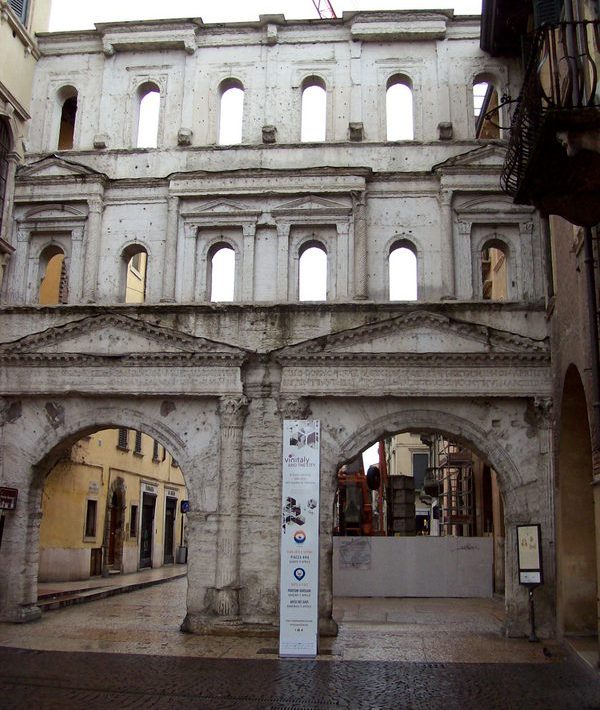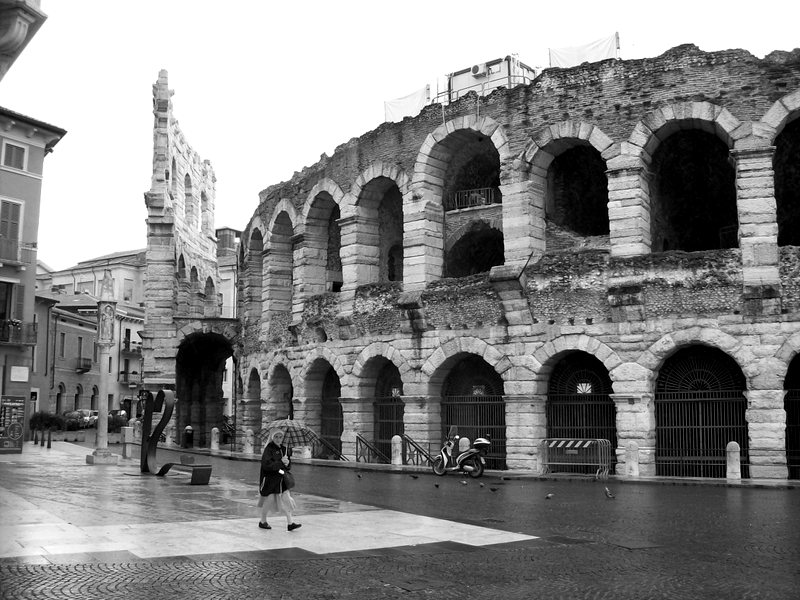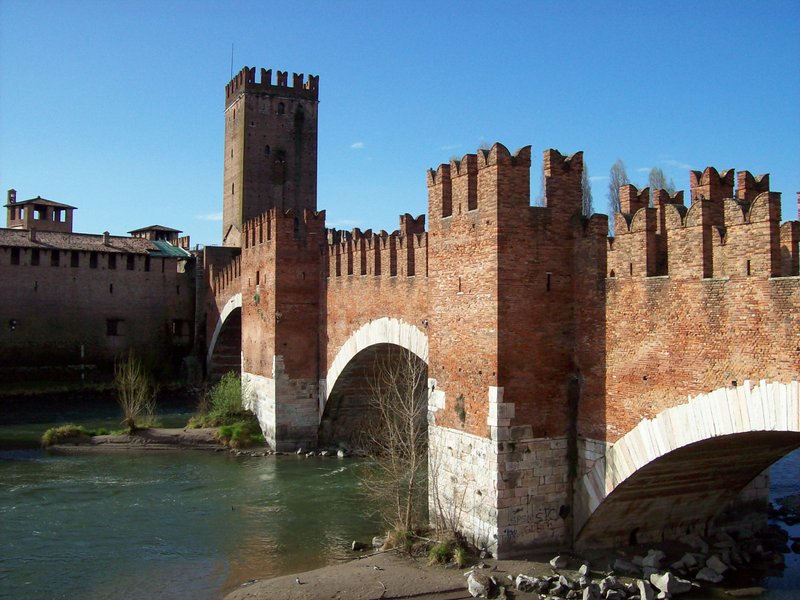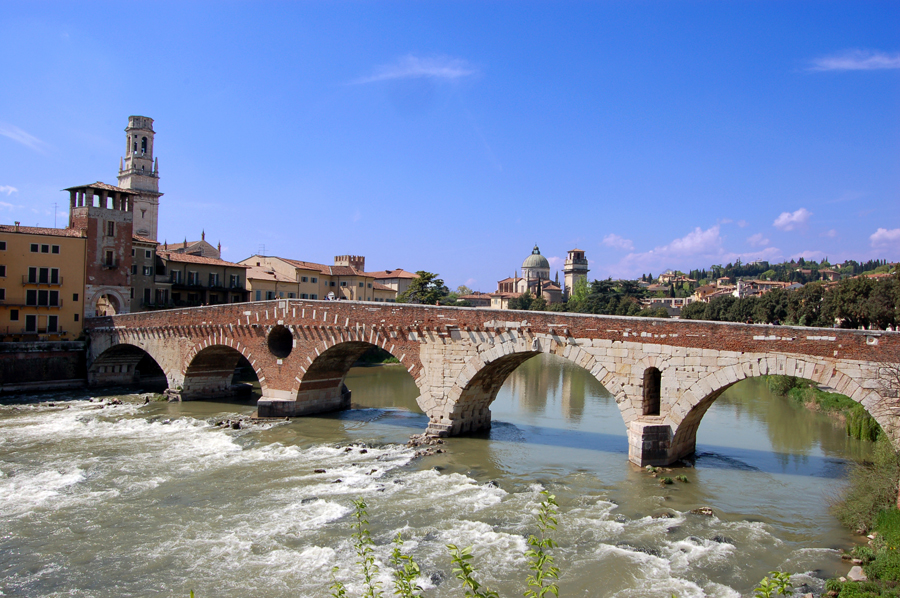A Visit To Verona Posted by Geoff on Apr 3, 2017 in Uncategorized
Here’s our English translation of last Friday’s blog Una Visita A Verona
Serena: Dove vuoi andare per prima cosa?
Geoff: A me piacerebbe vedere l’Arena, e quella porta Romana che abbiamo intravisto ieri dalla macchina.
Serena: Allora andiamoci subito prima che arrivino i turisti!
Geoff: La direzione la sai?
Serena: Suppergiù, ce l’hai quella mappa?
Geoff: Eccola!
Serena: Allora, noi siamo qua in Piazza delle Erbe, quindi … bisogna seguire Corso Porta Borsari, che è proprio il nome della porta Romana.
Geoff: E’ abbastanza vicina allora?
Serena: Sì, ci sono passata ieri con il gruppo quando tornavamo da Piazza Bra.
Geoff: Piazza Bra, che nome buffo! Cosa c’è lì, un enorme reggiseno?
Serena: Come sei scemo!
Serena: Where do you want to go first?
Geoff: I’d like to see the Arena, and that Roman gate that we glimpsed from the car yesterday.
Serena: Well then let’s go there straight away, before the tourists arrive!
Geoff: Do you know the way?
Serena: More or less, have you got that map? (N.B. the ‘ce’ in this construction is a common colloquialism, and has no actual translatable meaning.)
Geoff: Here it is!
Serena: Right, we’re here in Piazza delle Erbe, so … we need to follow Corso Porta Borsari, which is actually the name of the Roman gate.
Geoff: It’s quite close then?
Serena: Yes, I went past it yesterday with the group when we came back from Piazza Bra.
Geoff: Piazza Bra, what a silly name! What’s there, an enormous Bra?
Serena: What a nincompoop you are!
Seguiamo Corso Porta Borsari finché non arriviamo alla porta Romana.
We follow Corso Porta Borsari until we arrive at the Roman gate.
Geoff: Wow, che spettacolo … è bellissima!
Serena: Sì, molto bella!
Geoff: Wow, spectacular … it’s beautiful!
Serena: Yes, really lovely!
Sotto un portico alla sinistra di Porta Borsari c’è un mucchio di coperte con dentro un barbone con, accanto a lui, una sedia a rotelle.
Beneath a portico to the left of Porta Borsari is a heap of blankets with a tramp inside them and, next to him, a wheelchair.
Geoff: Vedi, magari le cose non sono cambiate molto dai tempi dei Romani!
Serena: Dai, andiamo di qua, se seguiamo via Oberdan arriviamo dritti dritti all’Arena.
Geoff: See, perhaps things haven’t changed much since Roman times!
Serena: Come on, let’s go this way, if we follow via Oberdan we’ll get straight to the Arena.
L’Arena di Verona è uno splendido anfiteatro Romano, costruito nel primo secolo d.C. All’epoca era capace di 30.000 posti. Per saperne di più, vedi qui: L’Arena Di Verona
Sbuchiamo in Piazza Bra e, quasi contemporaneamente, anche il sole fa capolino da dietro le nuvole. La scena è mozzafiato e, con grande sollievo di Geoff, scarsa di turisti.
Verona Arena is a splendid Roman Amphitheatre, built in the first century A.D. At the time it had a seating capacity of 30,000. To find out more about it look here: L’Arena Di Verona
We pop out into Piazza Bra, and almost at the same time the sun peeps out from behind the clouds. The scene is breathtaking and, to Geoff’s great relief, almost empty of tourists.
Geoff: Mi fai una foto sotto i portici dell’anfiteatro che la voglio mandare a mia mamma?
Geoff: Will you take a photo of me under the porticoes of the Amphitheatre, because I want to send it to my mother? (alternatively: so that I can send it to my mother)
Serena, indicando il Liston, la pavimentazione creata nel 1770 per il passeggio: Lì è dove ieri sera io e i miei amici abbiamo preso l’aperitivo, un Aperol Spritz, mentre tu facevi la pennichella.
Serena, indicating the Liston, the paved pedestrian area created in 1770: That’s where my friends and I had our aperitif yesterday evening, an Aperol Spritz (a popular cocktail), whilst you took a nap.
Geoff: Mmm, doveva essere molto atmosferico! Adesso dove vuoi andare?
Serena: Voglio vedere il Ponte Scaligero. Andiamo di qua.
Geoff: Mmm, it must have been very atmospheric! Where do you want to go now?
Serena: I want to see the Scaligero bridge. Let’s go this way.
Dopo pochi minuti arriviamo in fondo a via Roma e davanti a noi si apre la vista sul fiume Adige. Un edificio tutto di mattoni rossi ne blocca l’accesso. Castelvecchio, la fortezza costruita nel XIV secolo su volere di Cangrande II. Da qui raggiungiamo il ponte Scaligero.
After a few minutes we get to the end of via Roma where a view upon the river Adige opens up before us. A building constructed completely in red brick blocks the way. Castelvecchio, the fortress built in the 14th century at the behest of Cangrande II. From here we get to the Scaligero bridge.
Serena: E’ ancora più suggestivo di quanto non mi immaginassi!
Geoff: Fantastico! Mi piacciono troppo i merli a coda di rondine, sono molto caratteristici, vediamo se riesco a fargli una foto …
Serena: It’s even more atmospheric than I imagined!
Geoff: Fantastic! I really like the dovetail battlements, they’re very distinctive, let’s see if I can get a photo of them …
Geoff: Ti voglio far vedere il bellissimo Ponte Romano che ho visto ieri sera quando tu chiacchieravi coi tuoi amici. Cosa dici, seguiamo il lungofiume?
Serena: Va bene.
Geoff: I want to show you the beautiful Roman bridge that I saw yesterday when you were chatting with your friends. What do you say, shall we follow the riverside?
Serena: Okay.
Ci dirigiamo verso la zona dove restano il Teatro Romano e il Ponte Pietra, il ponte costruito dai Romani, e completato nel 100 a.C.
We head towards the area of the Roman theatre and Ponte Pietra, the bridge built by the Romans and completed in 100 B.C.
Geoff: Vedi che spettacolo?
Serena: Stupendo, e con questa vista delle colline tutto intorno è ancora più bello!
Geoff: See how spectacular it is?
Serena: Stunning, and with this view of the surrounding hills it’s even more beautiful!
Decidiamo di finire il nostro piccolo giro di Verona con una visita alla Casa di Giulietta per vedere il famoso balcone ….
Diciamo solo che, quello che ci aspettava non era quello che ci aspettavamo … come vi racconteremo prossimamente!
We decide to finish our little tour of Verona with a visit to Juliet’s house to see the famous balcony (from Shakespear’s ‘Romeo and Juliet’) …
Let’s just say that what awaited us wasn’t what we expected … as we’ll soon relate to you!
How did you get on, and how many of you had problems with this sentence: “Diciamo solo che, quello che ci aspettava non era quello che ci aspettavamo …“?
Don’t worry, all will be explained in Serena’s next article.
If there are any aspects of the translation that you feel need further clarification please leave a comment.
A presto!

Build vocabulary, practice pronunciation, and more with Transparent Language Online. Available anytime, anywhere, on any device.









Comments:
Joan Engelhaupt:
E’ ancora più suggestivo di quanto non mi immaginassi!
What’s that “non” doing in there?
Thanks for any help you can give me!
Serena:
@Joan Engelhaupt Salve Joan, salve Suzi!
The ‘non’ belongs to ‘finché. Finché non means ‘until’. Check this old post: https://blogs.transparent.com/italian/finch-o-finch-non/
Saluti da Serena’
Suzi:
Salve Serena e Geoff. Mi è piaciuto la vostra escursione! I have a similar question to Joan’s re ‘non’ in “finiche non arriviamo” Does “finiche non” mean until – in my first reading I saw “finiche – then put “non arriviamo” together and was a little confused!!
Also can you help me with “dritti dritti” with the words repeated? Grazie. Suzi
Serena:
@Suzi Brava Suzi!
Dritto dritto (dritta dritta, dritti dritti, dritte dritte) means ‘straight’
The repetition of words like ‘dritti dritti’ is very common in spoken Italian, e.g. ‘piano piano’, ‘man mano’ (both mean ‘gradually’), ‘bel bello’ (calmly).
Saluti da Serena
Suzi:
@Serena Ho letto il tuo blog Piccante Piccante che spiega tutto.
Tanto tanto grazie!
Mike Rose:
I translated “sedia a rotelle” as a swivel office chair, as I had this bizarre thought that the tramp got up in the morning, sat on his executive chair with a small accordion and put down his cap for a few tourist euros.
Spent ages on last sentence and ended up with “Only we say ,that which one expects isn’t that which we expect – how we will tell you precisely!”
Geoff:
@Mike Rose Ciao Mike, hmm, interesting translation!!!
Have you seen Serena’s latest blog? It should help you out with the aspettare/aspettarsi dilemma!
A presto, Geoff 🙂
Edward Dowson:
I am trying to translate “finché non arriviamo alla porta Romana.” which I translated as, “until we didn’t arrive at the Roman Gate”, which doesn’t make sense. More sensibly it means “arrived at”
Can you explain please.
Thank you
Serena:
@Edward Dowson Salve Edward!
In this sentence ‘finché’ is followed by ‘non’, which is a false negative. Check these posts for a detailed explanation:
https://blogs.transparent.com/italian/finch-o-finch-non/
https://blogs.transparent.com/italian/italian-false-negatives/
Saluti da Serena